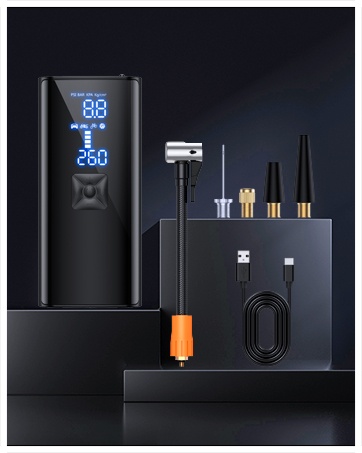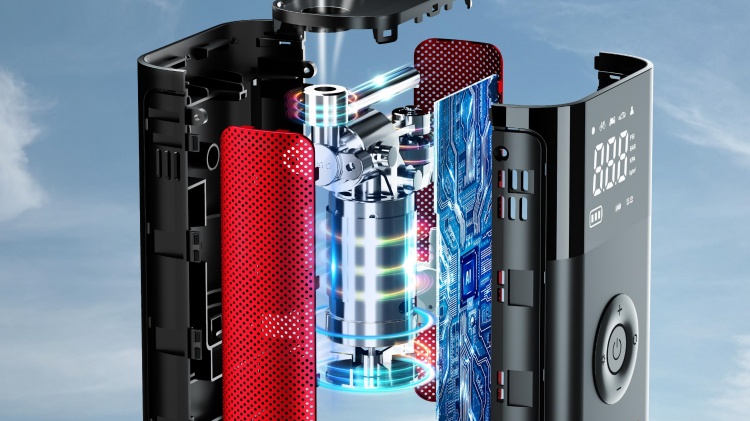An electric air compressor is a major investment designed to provide years of reliable service. But the pump will only last if properly cared for between uses. This article provides practical tips on storage, maintenance, and care to maximize your electric pump’s lifespan.

Why proper storage matters
Mindful storage keeps your air compressor in optimal operating condition:
- Prevents moisture buildup from humidity that causes internal corrosion, rust, and mold over time.
- Avoids dust and debris intrusion that can clog components like valves, filters, and critical cooling fins.
- Protects from extreme hot or cold temperatures that accelerate wear on seals, hoses, belts and other rubber or plastic parts.
- Deters pests like mice, squirrels, and insects from nesting inside control panels and housings when not in use. Chewed wires are dangerous fire hazards.
- Keeps all accessories together so necessary parts don’t get misplaced or damaged.
- Allows quick, convenient access when you need to use the compressor urgently or unexpectedly.
The best storage locations
The ideal places to store your electric air pump include:
Garage: A clean, dry garage often provides suitable conditions – moderate stable temps, low humidity, and secure enclosed storage off the concrete floor. Hang the pump from the ceiling or place up on a sturdy shelf to save space.
Garden shed: Well-ventilated wooden or metal sheds can work if protected from moisture and extreme temperatures. Place the compressor up on blocks or pallets above the floor away from dampness.
Basement: An unfinished but dry basement can provide good storage if elevated off concrete floors prone to moisture. Use a dehumidifier and fans to keep the space ventilated.
Storage closet: An empty coat closet or storage closet makes useful protected indoor storage. Install vent louvers in the door if the closet lacks sufficient airflow.
Where not to store your air compressor
Avoid storing your electric pump in unsuitable places like:
- Outdoors are fully exposed to the elements where they will deteriorate. Rain, sun, wind, and humidity will shorten its lifespan.
- Small confined utility rooms or basements with poor ventilation lead to overheating when operated.
- Uninsulated sheds with large temperature swings from seasonal changes. Condensation forms on cold surfaces.
- Any flooded, damp, or wet basement areas where moisture from the ground seeps in. This will lead to internal rust over time.
- Near furnaces, water heaters, or other heat sources can warm the unit and hose materials past safe limits.
General storage recommendations
Follow these guidelines to properly store your air compressor:
- Select a dry, well-ventilated area protected from weather and humidity whenever possible.
- Ideal storage temperatures range from 40-90°F. Avoid extreme cold or severe heat year-round.
- Place the unit on an elevated shelf or hang from the ceiling with chains to conserve floor space.
- In humid climates, drape a plastic tarp or canvas cover over the pump as an extra moisture barrier.
- Coil air hoses neatly and bind with velcro straps to minimize clutter and prevent kinks or tangles.
- In attached garages, fully enclose the pump in sealed plastic bins or bags to reduce dust and debris exposure.
- Set non-toxic glue traps around the perimeter if stored in a barn or shed to prevent mice and insects from entering the housing.
- For portable compressors, store them upright in an impact-resistant case to prevent internal damage.

Storing electric pumps outdoors
If outdoor storage is your only option:
- Place the unit underneath a waterproof outdoor-rated canopy or enclosure with adequate airflow and clearance around the pump.
- Elevate the compressor above ground level on concrete pavers, treated wood planks, or a metal stand to reduce moisture exposure.
- Use weatherproof metal shrouds, covers, and housings to protect from direct sun, rain, hail, and falling debris.
- Allow ample space around all sides for proper airflow to prevent overheating. Don’t enclose completely.
- Apply rust inhibitors and lubricants to all exposed metal pipes, nuts, bolts and components. Reapply annually.
- Insulate any water lines and coolant hoses to prevent them from freezing and cracking in cold winter climates. Heat tape also helps.
- Keep grass, weeds, and other vegetation cleared at least 2 feet away from the compressor housing to reduce moisture and fire risks.
Ongoing electric pump maintenance
Consistent maintenance is crucial for longevity and peak performance. Here are key tasks to perform:
- Wipe down the entire exterior after each use with a clean rag to prevent dirt, dust, and grease buildup.
- Fully drain moisture from air tanks regularly via ball valves or petcock drains to minimize internal corrosion.
- Replace air intake filters based on operating hours used to maintain proper airflow. Clogged filters reduce performance.
- Change compressor pump oil and oil filters as recommended by the manufacturer to protect internal components.
- Inspect belts, fittings, nuts, hoses, and connections. Tighten or replace any worn, loose, cracked or damaged parts.
- Confirm check valves and pressure relief safety valves function properly. Replace faulty valves immediately.
- Annually test gauge accuracy against a certified master pressure gauge. Recalibrate or replace gauges that are off.
Seasonal maintenance checks
In addition to regular care, perform seasonal checkups:
Fall/Winter:
- Deep clean the exterior housing, vents, and cooling fins before winter storage after the usage season ends.
- Change oil and filters before winter to remove any built-up condensation within the pump.
- Insulate any water lines and coolant hoses from freezing temperatures. Heat tape also helps.
Spring/Summer:
- Test overall pump operation after any long-term winter storage before relying on it.
- Replace oil, lubricants, belts, seals and filters after winter months per manufacturer recommendations.
- In peak summer heat, rigorously clean all accumulated motor and compressor dust monthly to avoid overheating.
- Lubricate condensers, bearings, bushings and other friction points with approved lubricants before summer usage per maintenance schedule.
Protecting electric pumps from moisture
Moisture is the biggest threat to air compressor longevity and functionality over time. Here are ways to reduce moisture exposure:
- Fully drain air tanks after every use via ball valves or petcock drains. Let all condensed moisture escape before closing caps.
- Install inline air dryers to actively filter water vapor out of incoming compressed air before it ever enters the tank. Highly recommended for humid climates.
- For portable compressors, situate the unit on 2×4 wood blocks or plastic pallets to minimize contact with damp concrete garage floors.
- Use only metal shrouds, covers and housings over pumps stored in sheds or outdoors instead of canvas, nylon or other porous covers that retain moisture.
- Keep all housing, panel and access door gaskets well-sealed and in good condition to contain compressed air and prevent leaks where moisture can enter.
Safe electric pump storage
Exercise safety precautions when storing your air compressor:
- Always unplug the power cord and neatly coil it to prevent tripping hazards. Never leave it plugged in.
- For gasoline-powered compressors, fully drain the fuel tank or add fuel stabilizers to prevent stale gasoline issues when restarting.
- Safely release all stored compressed air pressure via pressure relief valves on tanks before extended storage periods.
- Fully detach any quick-connect air hoses before storage to avoid accidental started inflation.
- Ensure condensation is fully drained from tanks periodically to minimize internal corrosion over time.
- Place the compressor high up or behind lockable doors where children cannot access cords/buttons.
Following proper storage, maintenance and care practices will extend the service life of your electric air compressor for years to come. Protect your investment by implementing these practical tips on choosing the optimal location, upkeep, and safe storage methods. Show your pump some TLC and it will reliably deliver optimal compressed air performance whenever you need it.
Troubleshooting common electric air pump problems
Even with regular maintenance, air compressors can sometimes malfunction. Here’s how to troubleshoot the most common electric pump issues:
Pump Fails to Start
- Check all power connections and supply wiring for damage. Inspect cord insulation for cracks. Replace damaged wires.
- Ensure the compressor is securely plugged into a working grounded outlet with the proper voltage. Try another outlet.
- Reset any tripped circuit breakers or replace blown fuses in the electrical panel.
- Test the electrical outlet with a table lamp to verify if the power is present.
- For gasoline-powered units, check fuel levels. The choke may need to be open once started.
- Faulty pressure sensor switches, relays, or start capacitors can prevent startup. Test and replace any defective components.
Pump Runs But Has Weak/No Airflow
- Listen closely to air leaks and re-seal any leaky gaskets, valves, fittings or connections. Tighten hardware or replace damaged seals.
- Thoroughly inspect air filters and all inlet openings and pathways. Clear any obstructions and replace clogged filters.
- Check discharge valves move freely and are not stuck closed or obstructed by debris. Clean or replace.
- Examine piston rings and cylinder walls for wear or damage. Worn rings or scored cylinders reduce compression. Replace damaged piston assemblies as needed.
- Verify V-belts are properly tensioned and aligned. Tighten belts or realign pulleys if slipping.
- Confirm proper lubrication levels – refill oil or grease friction points if low. Thin lubricants cause excess slippage and wear.
Pump Rapidly Cycles On and Off
- Dirty or clogged air filters can cause short cycling from insufficient airflow. Replace filters.
- Inspect that inlet and discharge check valves fully close and seal when the compressor stops and after it reaches cutoff pressure. Listen closely for leaks.
- Confirm operating temps are in spec and avoid heat buildup by allowing cooling periods between inflation sessions.
- Check pressure sensor switch tubing for kinks or obstructions. Test switch continuity with multimeter. Replace faulty switches.
- Air demands may exceed compressor sizing if it cannot maintain pressure. Right-size the pump capacity for the application’s CFM needs.
Excessive Noise and Vibration When Running
- Verify compressor rests solidly on a level surface and doesn’t vibrate, bounce or drift when operating.
- Listen for any loose fittings, bolts or components that may rattle when subjected to vibrations. Tighten appropriately.
- Check alignment on belt driven pumps. Realign motor and compressor shafts if needed.
- Inspect bearing housings for cracks or damage. Replace bearings making grinding, squealing or whining noises indicative of wear.
- Out of balance flywheels can cause excessive vibrations. Remove and rebalance or replace wobbly flywheels.
- Lubricate motor and pump mounting bolts/bushings to dampen vibrations transmitted through the frame.
Overheating Problems
- Don’t exceed duty cycle ratings. Allow proper cooling periods of at least 10-15 minutes between work sessions.
- Make absolutely sure cooling fins and ventilation openings on the pump and motor are clean and unobstructed. Carefully clean built-up dust and debris.
- Provide ample clearance around the compressor with sufficient airflow. Avoid tightly confined spaces trapping heat.
- Open doors or windows and use temporary cooling fans to lower ambient temperatures in the compressor room. Provide shade on severely hot days.
- Check for seized, stuck or worn piston rings allowing hot combustion gases to bypass the rings. Replace damaged pistons and rings.
- Ensure adequate coolant levels. Check coolant system for leaks. Clean radiator cooling fins carefully with compressed air to maintain ventilation.
With proper troubleshooting and maintenance, your electric pump will operate reliably for many years. But for repairs involving substantial disassembly or electrical work, always consult a certified technician for safety.

Best practices to maximize electric air compressor longevity
Implement these tips to extend the operating lifespan of your air compressor:
Purchase Quality Equipment
- Invest in leading professional brands known for proven reliability, performance, and durability in your operating environment.
- Opt for all-metal cast iron or steel construction for longevity rather than plastic housings which can crack, warp and vibrate.
- Select reputable manufacturers that have been in the compressor business for decades and stand behind their products.
Size the Pump Appropriately
- Match the pump’s discharge volume (CFM) and pressure (PSI) ratings to your projected air demands. Under or over-sizing shortens motor and component life.
Allow Proper Airflow
- Position the compressor with at least 1 foot of clearance on all sides for proper cooling and ventilation airflow. Avoid confined spaces.
Use an Air Intake Filter
- Install a quality intake filter to scrub incoming air of particulates that can quickly damage internal pump components.
Check Lubricant Levels Diligently
- Maintain proper lubrication levels at all times during usage seasons. Low oil causes mechanical wear and overheating damage.
Follow Preventative Maintenance Intervals
- Closely adhere to all maintenance schedules for cleaning, lubrication, filter changes and parts replacement as directed. This prevents premature breakdowns.
Allow Sufficient Motor Cooling
- Let the pump cool down for at least 10-15 minutes between heavy use sessions to prevent overheating damage to seals, windings, etc.
Keep Compressor Exterior Clean
- Always wipe down the housing after use and store it in a clean, dry space away from condensation-forming temperature swings.
- Caring for your electric air pump properly ensures decades of flawless functioning.
Follow these tips to get the longest operating lifespan and best performance from your compressor. Keep your pump in top shape and it will provide years of reliable service.













